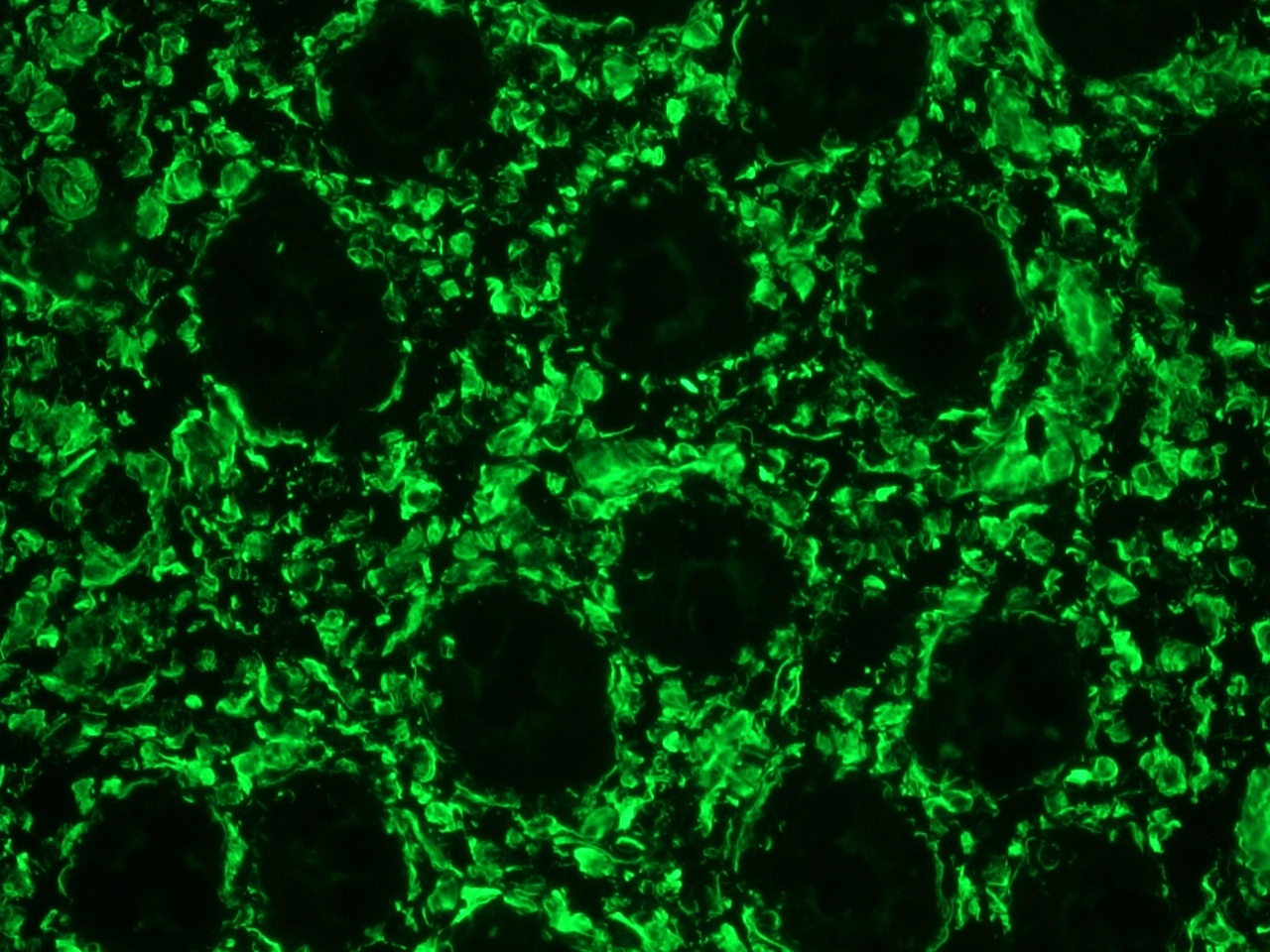Catalogue

Mouse anti Vimentin, conjugated with FITC
Catalog number: MUB1900L1-CE/IVD| Clone | RV202 |
| Isotype | IgG1 |
| Product Type |
Primary Antibodies |
| Units | 1 ml |
| Host | Mouse |
| Species Reactivity |
Canine Caprine Chicken Hamster Human Monkey Mouse Rat Swine Xenopus Zebrafish |
| Application |
Flow Cytometry Immunocytochemistry Immunohistochemistry (frozen) |
Background
Vimentin (57 kDa) is the intermediate filament protein (IFP) of mesenchymal cells. This IFP however often deviates from the tissue-specific and developmentally regulated pattern of expression. Besides its typical expression in most cultured cells, vimentin is also expressed together with several other IFPs during early stages of development. As differentiation proceeds, vimentin is exchanged for the tissue-specific intermediate filament type. Also in cancers, vimentin is often expressed in addition to the tissue-specific IFP.
Source
RV202 is a mouse monoclonal IgG1 antibody derived by fusion of SP2/0-Ag14 mouse myeloma cells with spleen cells from a BALB/c mouse immunized with a cytoskeletal vimentin extract of calf lens.
Product
Each vial contains 1ml FITC-conjugated vimentin monoclonal antibody in PBS containing 0,1% BSA, 0.09% sodium azide. Approximately 100 tests.
Product Form: FITC
Formulation: Each vial contains 1ml FITC-conjugated vimentin monoclonal antibody in PBS containing 0,1% BSA, 0.09% sodium azide. Approximately 100 tests.
Specificity
RV202-FITC reacts exclusively with vimentin, which is expressed in mesenchymal cells and mesenchymal derived tumors e.g. lymphoma, sarcoma and melanoma. RV202-FITC is suitable for immunocytochemistry on cell cultures and cytospins, immunohistochemistry on frozen tissues, as well as for flow cytometry. Optimal antibody dilution should be determined by titration; recommended dilution is 1:10.
Species Reactivity: Pieper et al (European Journal of Biochemistry 1992; included) show in figure 5 and 6 that replacement of exons 7-9 in the vimentin gene (construct Vvim2) results in a vimentin protein that is no longer detected by RV202, indicating that the epitope for RV202 is located in the C-terminal region of vimentin, comprising amino acid range 409-466 . RV202 has a very broad species cross-reactivity, ranging from human to Xenopus, and must therefore recognize an evolutionary conserved amino acid sequence.
Storage
The antibody is shipped at ambient temperature and may be stored at +4°C. For prolonged storage prepare appropriate aliquots and store at or below -20°C. Prior to use, an aliquot is thawed slowly in the dark at ambient temperature, spun down again and used to prepare working dilutions by adding sterile phosphate buffered saline (PBS, pH 7.2). Repeated thawing and freezing should be avoided. Working dilutions should be stored at +4°C, not refrozen, and preferably used the same day. If a slight precipitation occurs upon storage, this should be removed by centrifugation. It will not affect the performance or the concentration of the product.
Caution
When used for in vitro diagnostic purposes results must be put within the context of other diagnostic tests as well as the clinical history of the patient by a certified professional before final interpretation. Analyses performed with this antibody should be paralleled by positive and negative controls. If unexpected results are obtained which cannot be attributed to differences in laboratory procedures, please contact us. This product may contain hazardous ingredients. Please refer to the Safety Data Sheets (SDS) for additional information and proper handling procedures. Dispose product remainders according to local regulations.This datasheet is as accurate as reasonably achievable, but Nordic-MUbio accepts no liability for any inaccuracies or omissions in this information.
References
1. Ramaekers, F., Huysmans, A., Schaart, G., Moesker, O., and Vooijs, P. (1987). Tissue distribution of Keratin 7 as monitored by a monoclonal antibody, Exp Cell Res 170, 235-49.
2. Viebahn, C., Lane, E. B., and Ramaekers, F. C. (1988). Keratin and vimentin expression in early organogenesis of the rabbit embryo, Cell Tissue Res 253, 553-62.
3. Pieper, F. R., Schaart, G., Krimpenfort, P. J., Henderik, J. B., Moshage, H. J., van de Kemp, A., Ramaekers, F. C., Berns, A., and Bloemendal, H. (1989). Transgenic expression of the muscle-specific intermediate filament protein desmin in nonmuscle cells, J Cell Biol 108, 1009-24.
4. Raats, J. M., Pieper, F. R., Vree Egberts, W. T., Verrijp, K. N., Ramaekers, F. C., and Bloemendal, H. (1990). Assembly of amino-terminally deleted desmin in vimentin-free cells, J Cell Biol 111, 1971-85.
5. Ramaekers, F., van Niekerk, C., Poels, L., Schaafsma, E., Huijsmans, A., Robben, H., Schaart, G., and Vooijs, P. (1990). Use of monoclonal antibodies to keratin 7 in the differential diagnosis of adenocarcinomas, Am J Pathol 136, 641-55.
CE Mark
CE
Safety Datasheet(s) for this product:
| NM_Sodium Azide |

|
Immunofluorescence staining of frozen section of human colon using MUB1900L1. Note reactivity in connective tissue while epithelial cells remain negative. |

Immunofluorescence staining of frozen section of human colon using MUB1900L1. Note reactivity in connective tissue while epithelial cells remain negative.
